Overview
Healthcare system integration is paramount for addressing the complexities of modern healthcare. By establishing clear goals, engaging stakeholders, and investing in robust technology solutions that facilitate interoperability, we can significantly enhance patient care and reduce costs.
Are you aware of the challenges posed by fragmented systems? This article underscores that implementing these best practices is essential for overcoming such obstacles, thereby ensuring a successful integration process.
By prioritizing these strategies, healthcare organizations can not only streamline operations but also improve patient outcomes, making a compelling case for immediate action.
Introduction
In an age where healthcare systems often operate in silos, the push for integration has never been more critical. By unifying diverse technologies and facilitating seamless communication, healthcare integration not only enhances patient care but also optimizes operational efficiency. As organizations grapple with the complexities of modern healthcare demands, the integration of systems emerges as a vital strategy to improve outcomes and reduce costs.
With insights from industry leaders and advancements in technology, this article delves into the necessity of integrated healthcare systems, the various models available, and the role of innovative platforms like Avato in navigating the challenges and opportunities ahead. As the landscape evolves, understanding and implementing effective integration strategies will be key to delivering high-quality patient care in a rapidly changing environment.
Understanding Healthcare System Integration: A Comprehensive Overview
The integration of healthcare systems is focused on unifying various medical technologies and frameworks, enabling seamless communication and data transfer. This collaboration is essential for enhancing patient care, minimizing errors, and improving operational efficiency. In today’s medical landscape, where many systems operate in isolation, healthcare system integration provides a comprehensive view of patient information, allowing providers to make informed decisions swiftly.
The advantages of effective healthcare system integration are numerous. It can lead to improved patient outcomes, streamlined processes, and significant cost savings, making it a top priority for medical organizations striving to succeed in a rapidly evolving environment. Recent trends indicate that by 2025, healthcare system integration is increasingly being adopted to tackle regulatory challenges and implementation obstacles, with 30% of industry leaders identifying these as primary barriers to further investment in technologies like Blockchain.
This statistic underscores the urgency for organizations to embrace a unified approach to healthcare system integration to overcome these challenges. Expert opinions emphasize the importance of this integration in enhancing patient care. For instance, Gustavo Estrada from BC Provincial Health Services Authority stated, “This solution has streamlined intricate projects and produced outcomes within preferred timelines and budget limitations,” highlighting how successful coordination can transform medical service delivery. The hybrid connectivity platform is designed to facilitate healthcare system integration by unifying diverse systems, ensuring smooth and secure data connections that empower healthcare providers to enhance patient care.
Founded by a team of dedicated enterprise architects, the company is committed to crafting technology solutions that improve interconnected customer experiences. The name ‘Avato’ derives from the Hungarian term for ‘of dedication,’ reflecting the company’s mission to deliver exceptional unification services. Additionally, Avato offers a range of services, including:
- Enterprise architecture
- Solutions architecture
- Infrastructure architecture
- Business analysis
- Technical analysis
- Project management
- Interface design and development
- Software development
- Quality assurance
All aimed at accelerating digital transformation.
Moreover, advancements in technology, including the thorough examination of various sensors used in medical management frameworks for different conditions, are vital for enhancing collaborative efforts. These innovations enable more accurate monitoring and management of patient health, further improving the quality of care. Avato’s expert integration services assist businesses with skilled integration partners, ensuring that healthcare system integration allows organizations to leverage these technologies effectively.
Case studies, such as those conducted by the Commonwealth Fund, demonstrate that learning from successful health frameworks globally can inform U.S. health policy and improve care delivery. These studies indicate that healthcare system integration through integrated frameworks not only enhances operational efficiency but also significantly improves patient care by reducing errors and ensuring timely access to critical information. By linking these outcomes to the platform’s features, it is evident that organizations utilizing this system can achieve comparable successes in their integration efforts.
As we advance into 2025, the impact of healthcare system integration on patient outcomes continues to grow. Organizations prioritizing this integration, particularly through Avato’s specialized hybrid unification platform, are better positioned to adapt to changing demands, ultimately leading to a more efficient and responsive healthcare framework. Current statistics reveal that healthcare system integration is not merely a trend but a necessity for delivering high-quality patient care in an increasingly complex environment.
Additionally, innovations such as Wiechert et al.’s work in recording EEG brain waves with wearable headgear illustrate the ongoing advancements in technology that facilitate medical systems.
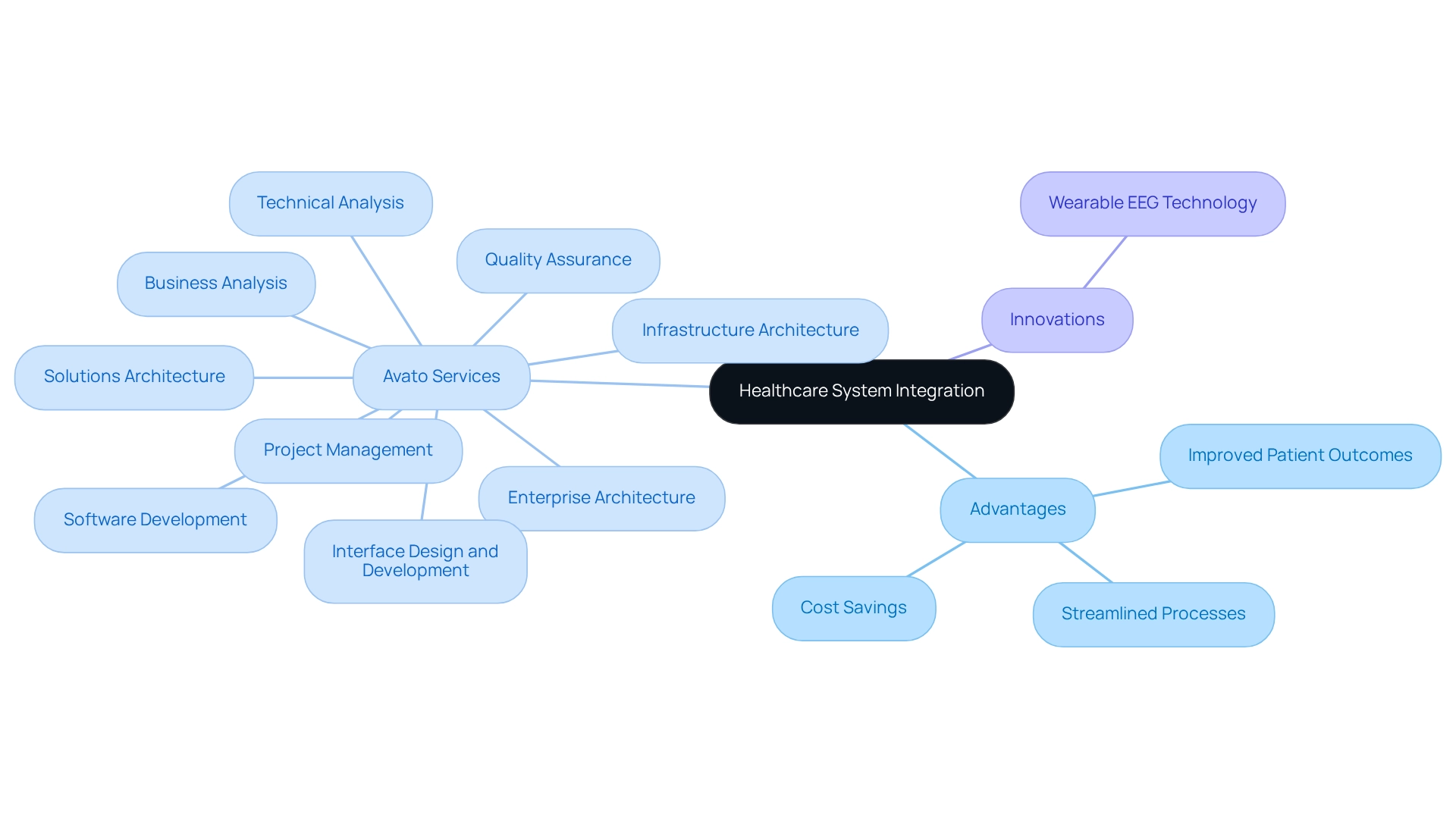
Exploring Different Models of Integrated Healthcare: Tailoring Approaches for Success
Several models of healthcare system integration exist, including vertical consolidation, horizontal consolidation, and virtual consolidation. Vertical consolidation unifies services across various levels of care—primary, secondary, and tertiary. The Secure Hybrid Connection Platform enhances this vertical connectivity by maximizing and extending the value of legacy technologies, ensuring effective linkage and management across all care levels.
Horizontal consolidation focuses on merging comparable services or providers to improve service delivery. In this context, the company simplifies complex connections, enabling medical organizations to streamline operations and enhance patient care. Virtual integration leverages technology to connect various platforms and providers without the need for physical unification. The platform provides real-time monitoring and alerts on performance, ensuring reliability and uptime. Each model offers distinct advantages and can be tailored to meet the unique needs of medical organizations, ultimately enhancing patient care and operational efficiency through healthcare system integration.
With the Secure Hybrid Integration Platform, organizations across banking, medical, and governmental sectors can effectively connect isolated legacy infrastructures. This integration significantly lowers expenses while improving overall performance. Are you ready to transform your healthcare system and elevate patient care? Embrace the power of integration today.
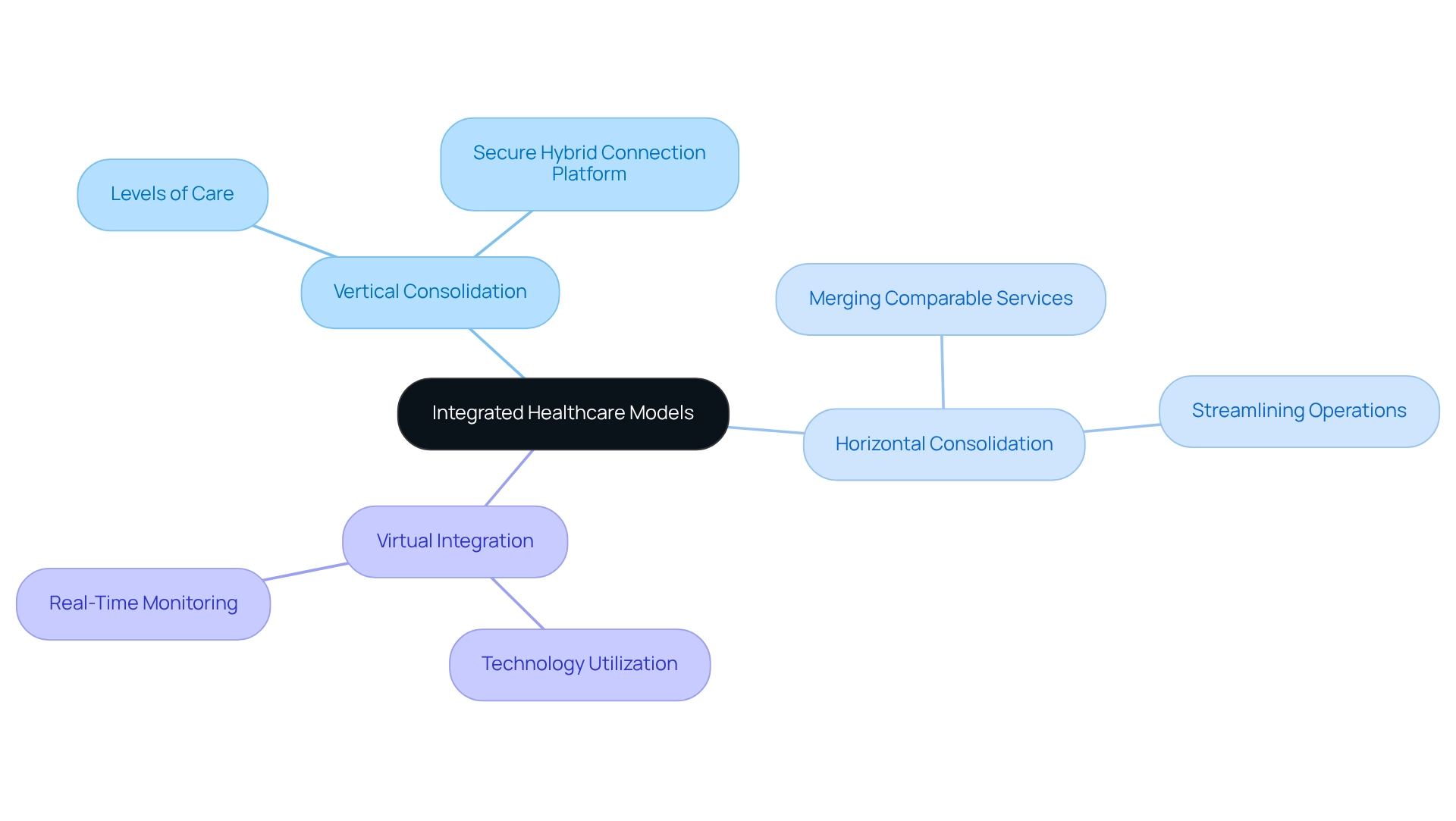
The Role of Technology in Healthcare Integration: Enhancing Interoperability and Efficiency
Technology stands as a cornerstone of successful healthcare system integration. Sophisticated connection platforms, such as the Hybrid Connection Platform, facilitate seamless data transfer across diverse networks, enhancing interoperability and ensuring continuous uptime and reliability. These platforms enable real-time data sharing, which is critical for timely decision-making in patient care.
By enhancing and extending the value of legacy systems, the company streamlines complex connections and significantly reduces costs, allowing healthcare organizations to access data and systems in weeks rather than months.
Furthermore, the platform supports 12 levels of interface maturity, enabling organizations to strike a balance between speed of implementation and the sophistication required to future-proof their technology stack. Technologies such as APIs, cloud computing, and electronic health records (EHRs) play a vital role in the unification process by standardizing data formats and improving accessibility. By leveraging these technologies alongside the robust features of Avato’s platform, healthcare organizations can achieve comprehensive system integration, streamline operations, reduce redundancies, and ultimately enhance patient outcomes.
Moreover, the application of XSLT for effective XML data transformation and the execution of schemas can lead to substantial cost reductions by minimizing programming errors and ensuring data integrity throughout the unification process, thereby improving overall efficiency.
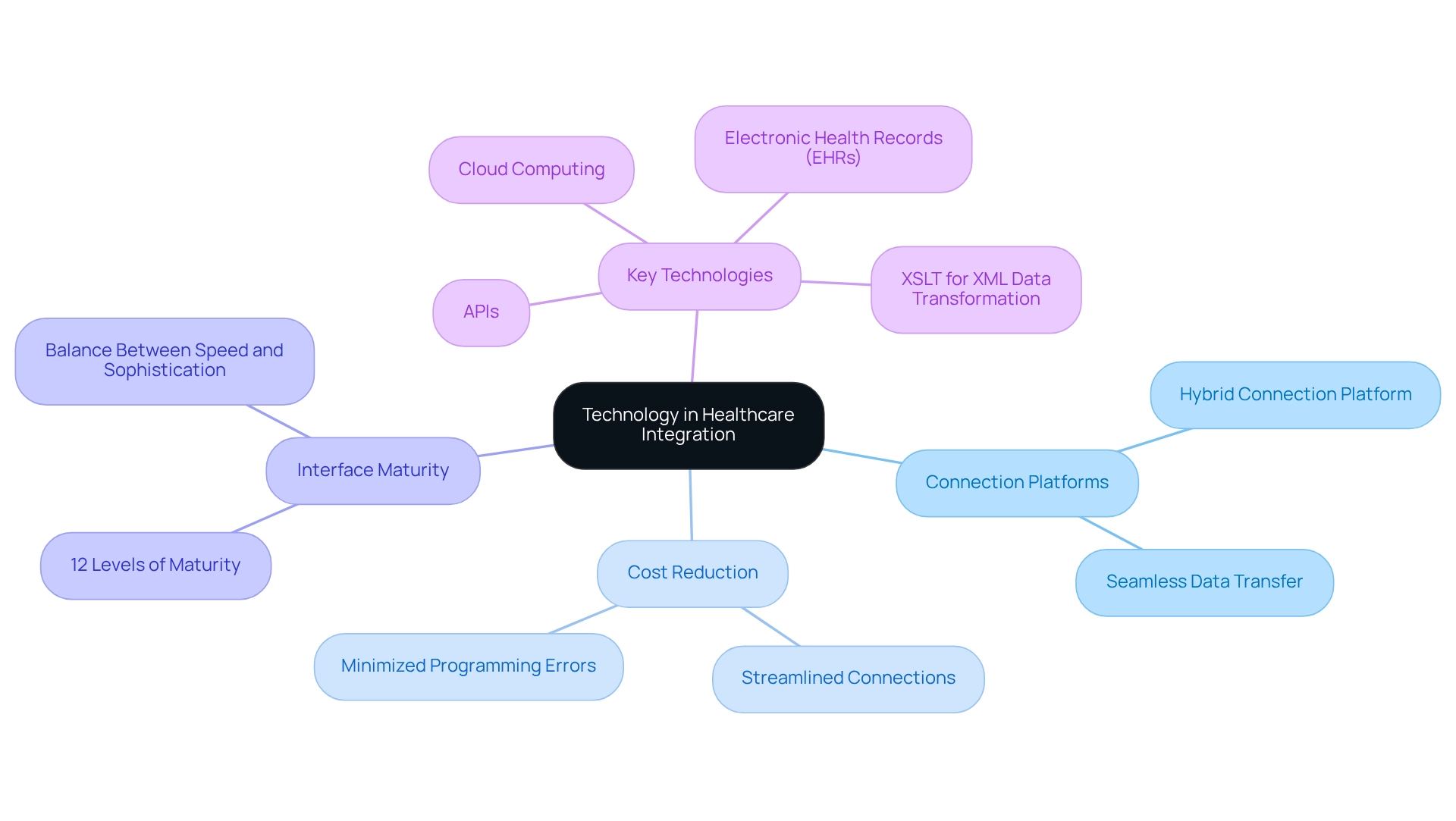
Navigating Challenges in Healthcare Integration: Strategies for Overcoming Obstacles
Healthcare unification faces significant challenges, including data silos, interoperability issues, and resistance to change among staff, all of which hinder effective system integration. To address these obstacles, organizations must adopt a phased approach, starting with pilot projects that demonstrate the benefits of integration. Early stakeholder involvement is crucial; mobilizing stakeholders ensures that requirements are accurately captured from the outset.
This proactive engagement cultivates a collaborative culture and effectively addresses concerns. Additionally, investing in training and support for employees is vital to facilitate the transition to integrated processes, aligning everyone with the changes. By implementing a hybrid connectivity platform, medical organizations can secure their systems for the future, enabling seamless integration of new tools with existing resources.
The company advocates for specific technologies and tools that accurately represent current and ideal states, which are essential for effective process modeling. By proactively tackling these challenges, medical organizations can pave the way for successful healthcare system integration, ultimately enhancing business value and creating connected customer experiences. Avato’s commitment to streamlining connections stems from its origins as a team of enterprise architects dedicated to simplifying complex challenges.
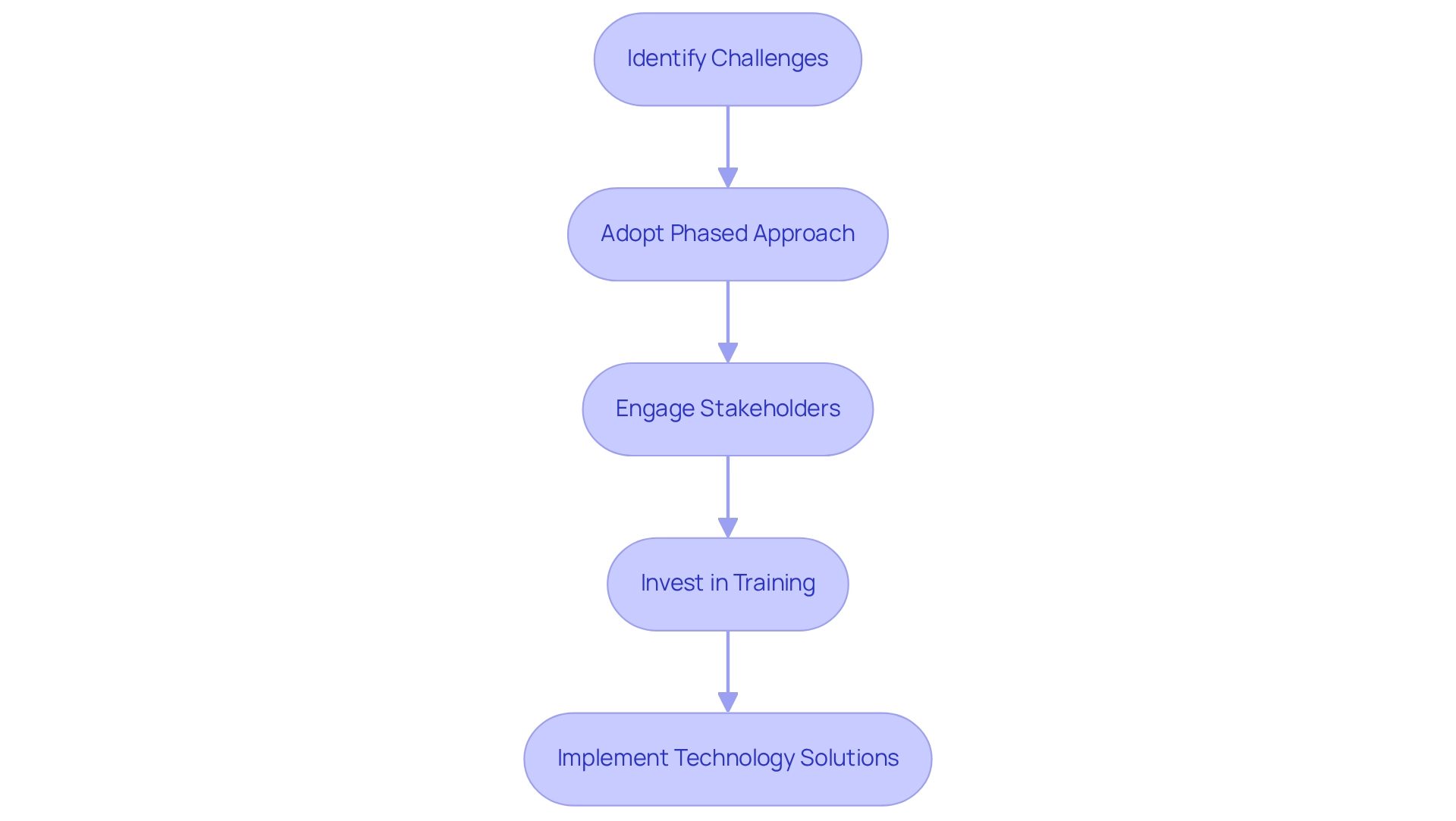
The Benefits of Successful Healthcare Integration: Improving Care and Reducing Costs
The effective integration of healthcare systems yields numerous advantages, significantly enhancing patient treatment, operational productivity, and cost-efficiency. By establishing a cohesive perspective of patient information, healthcare system integration empowers medical providers to make informed decisions that directly improve treatment outcomes. Studies indicate that organizations implementing integrated care models have reported up to a 30% reduction in hospital readmission rates, showcasing the tangible impact on patient care quality. This statistic is supported by a rigorous selection process for studies, ensuring that only relevant and high-quality research informs these findings.
Furthermore, optimized workflows resulting from healthcare system integration alleviate administrative pressures, allowing medical personnel to devote more time to direct patient care. This shift not only enhances the patient experience but also optimizes resource allocation, leading to substantial cost savings. For instance, healthcare facilities that have adopted integrated systems have documented a decrease in service duplication, translating to an average savings of 15% in operational costs.
The company plays a crucial role in this transformation, providing a dedicated hybrid platform designed to simplify complex connections and enhance business value. Key features of the platform include support for 12 levels of interface maturity, enabling organizations to balance the speed of incorporation with the sophistication needed to future-proof their technology stack. Designed for secure transactions, Avato is relied upon by banks, medical services, and government sectors, ensuring that projects maintain 24/7 uptime with no allowance for defects or outages. This reliability is essential for medical providers aiming to enhance patient care through effective data management.
The advantages of effective healthcare system integration extend into 2025 and beyond, as the sector increasingly recognizes the importance of unified frameworks. Real-world examples illustrate how integrated care models have transformed medical delivery, with organizations reporting improved collaboration among providers and enhanced patient satisfaction scores. As Roberta Piroddi notes, “To address inequalities, integrated care interventions need to be adapted to the specific needs of disadvantaged communities, and the effectiveness in those communities evaluated.” This perspective underscores the significance of customized unification strategies.
As the landscape evolves, the emphasis on healthcare system integration will remain vital in shaping effective medical strategies, ultimately fostering a more cohesive environment that benefits both providers and patients alike. For banking IT managers, the insights gained from medical system collaboration can inform strategies for enhancing data management and operational efficiency within their own organizations. By leveraging the company’s expertise in providing a robust connectivity foundation, banking IT managers can adopt similar connection strategies to bolster their operational capabilities.
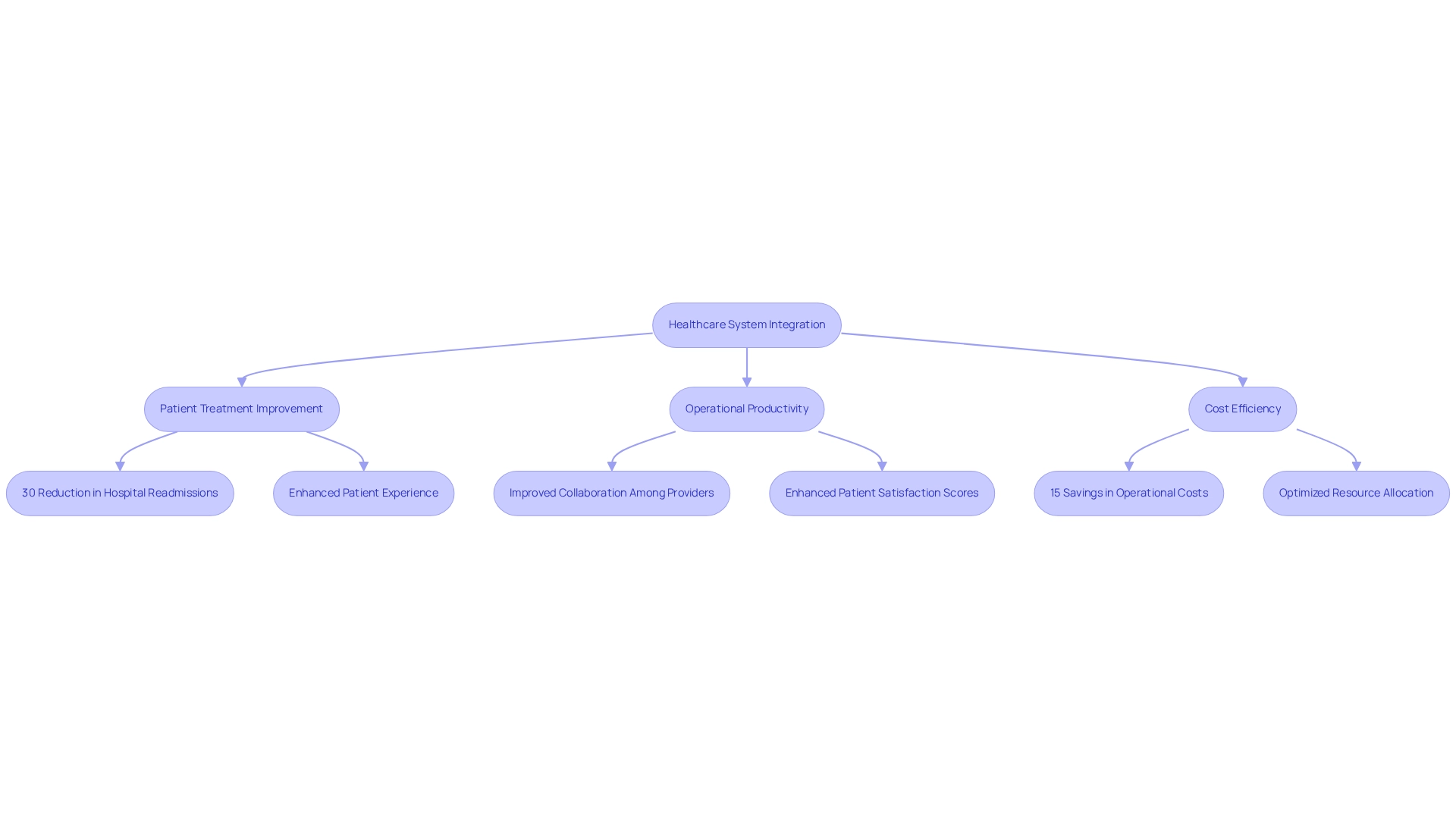
Best Practices for Implementing Integrated Healthcare Systems: Proven Strategies for Success
To effectively implement unified medical frameworks and promote healthcare system integration, organizations must adhere to several best practices. First, establish clear goals and objectives for unification, ensuring alignment with organizational strategy. Next, engage stakeholders throughout the process to foster collaboration and buy-in. Additionally, invest in robust technology solutions that facilitate interoperability and data sharing. Utilize expert services for seamless healthcare system integration and systems unification, including specialized projects in healthcare data management and interoperability.
Moreover, offer extensive training and assistance for personnel to ease the transition, ensuring they are prepared to use the hybrid connection platform effectively. It is also crucial to continuously monitor and assess the incorporation process, utilizing robust analytics capabilities to optimize operations and enhance customer experiences. Furthermore, organizations ought to evaluate potential expenses and schedules related to Avato’s services and investigate the project rescue service for assistance with current implementation challenges.
By following these best practices, medical organizations can significantly improve their prospects for successful healthcare system integration. Are you ready to take the next step towards a more integrated healthcare system?

Engaging Stakeholders in Healthcare Integration: The Key to Collaborative Success
Involving stakeholders is essential for the success of medical unification efforts. Stakeholders—comprising healthcare providers, administrative staff, patients, and technology vendors—must be engaged early in the unification process. This proactive approach allows organizations to gather valuable insights and address potential concerns effectively.
Consistent communication and feedback mechanisms play a crucial role in sustaining stakeholder involvement, ensuring alignment with unification objectives. Furthermore, the dedicated hybrid unification platform accelerates secure framework connections across banking, medical services, and government, providing a robust foundation for these initiatives. As Tony Leblanc from the Provincial Health Services Authority aptly states, ‘Good team. Good people to work with. Extremely professional. Extremely knowledgeable.’
Nurturing a culture of teamwork fosters creative solutions and enhances the efficiency of healthcare system integration. The organization’s commitment to healthcare system integration and increasing business value is evident in their method, ensuring that stakeholders are not only involved but also empowered to participate in the integration process. With support for 12 levels of interface maturity, Avato strikes a balance between speed of implementation and the sophistication required to future-proof technology stacks, embodying the foundational commitment of the company.
Are you ready to transform your healthcare integration efforts? Embrace the power of collaboration and technology to drive success.
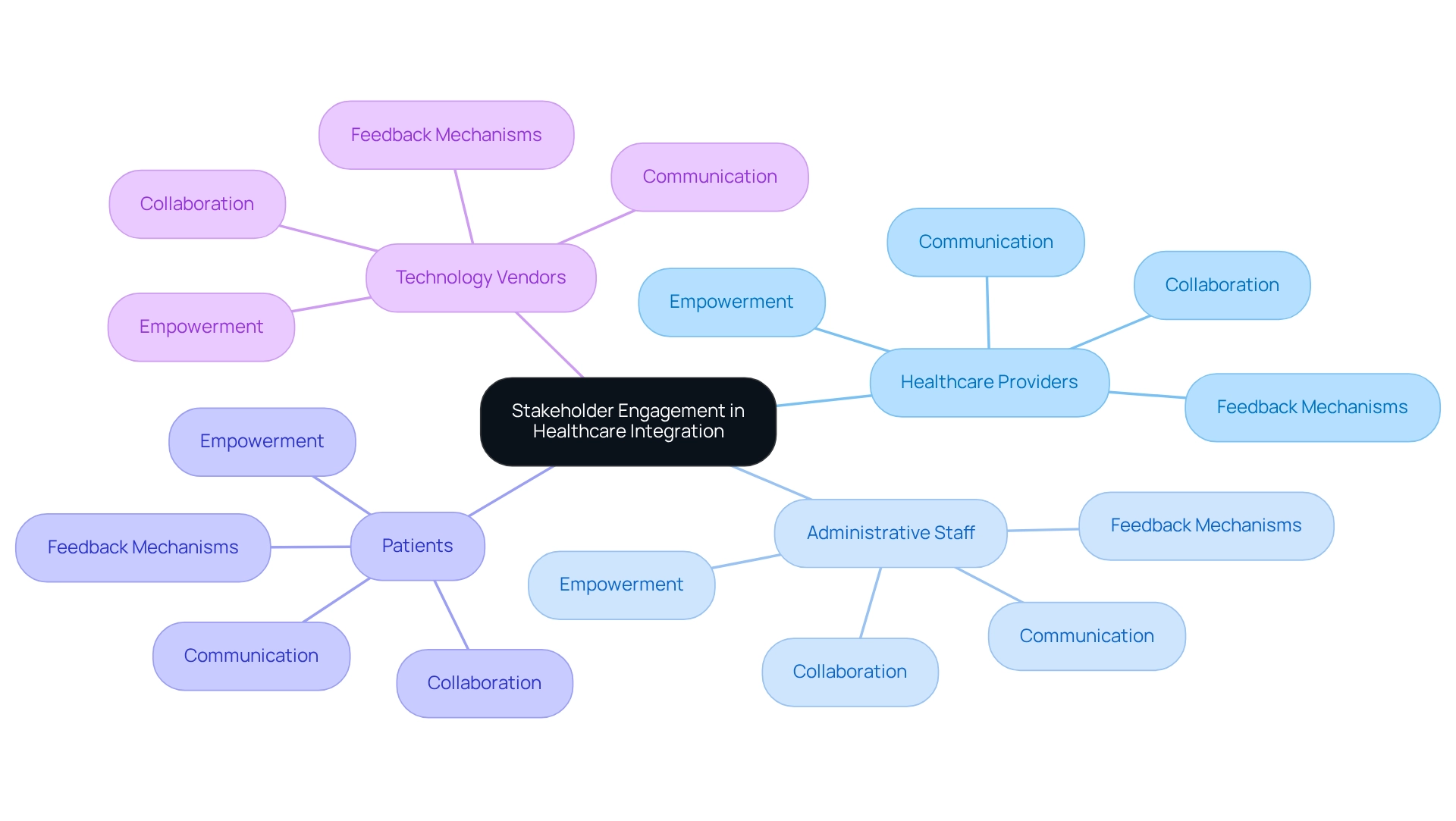
Future Trends in Healthcare Integration: Preparing for Tomorrow’s Challenges
As the medical landscape evolves, several key trends are poised to significantly impact healthcare system integration efforts. The rise of telehealth and remote patient monitoring is driving the demand for enhanced data sharing and interoperability among various networks. This transformation not only improves patient care but also compels medical organizations to reassess their collaboration strategies to achieve effective healthcare system integration for real-time data exchange.
Avato’s dedicated hybrid unification platform is instrumental in healthcare system integration, streamlining the connection of diverse networks and unlocking isolated resources to enhance business value.
Moreover, the increasing adoption of artificial intelligence (AI) and machine learning (ML) in healthcare is reshaping the integration landscape. As of May 2024, the FDA has approved 882 AI-powered devices, with radiology emerging as the leading application area. This trend underscores the necessity for healthcare system integration through unified frameworks capable of efficiently processing and analyzing vast amounts of data.
From 2015 to 2020, 129 (58%) AI/ML-based medical devices in the USA and 126 (53%) in Europe received approval for radiological use, highlighting the growing reliance on these technologies. Avato’s platform empowers organizations to prepare their operations for the future through seamless data and system unification, which is crucial for healthcare system integration and ensuring effective utilization of these advancements.
Organizations must also remain vigilant regarding regulatory changes that could affect their integration strategies. Addressing issues such as data quality, technical infrastructure, and ethical practices is essential for unlocking the transformative potential of AI in the medical field. A recent case study titled “Challenges in AI Adoption” revealed that overcoming these hurdles is vital for improving global health equity.
As Conor Stewart, a research expert in health & pharmaceuticals, noted, “A significant advantage of AI in the medical field could enable health professionals to experience reduced stress levels, less time working extra hours, and increased time devoted to direct patient care.”
Furthermore, emerging technologies, such as wireless sensors for remote tracking of sleep and behavior, and AI systems that automate administrative duties in medical settings, are enhancing clinician efficiency and further shaping coordination strategies. The company, named after the Hungarian term for ‘dedication,’ is committed to building the technological foundation necessary for these innovations. This dedication, combined with the expertise of the team in unifying processes, enables medical organizations to adapt and thrive in this dynamic environment.
By staying informed about these trends and adjusting their strategies for healthcare system integration accordingly, healthcare organizations can position themselves for future success. The integration of telehealth and AI not only boosts operational efficiency but also enhances patient outcomes, making it imperative for organizations to embrace these advancements with the support of Avato’s hybrid integration platform.
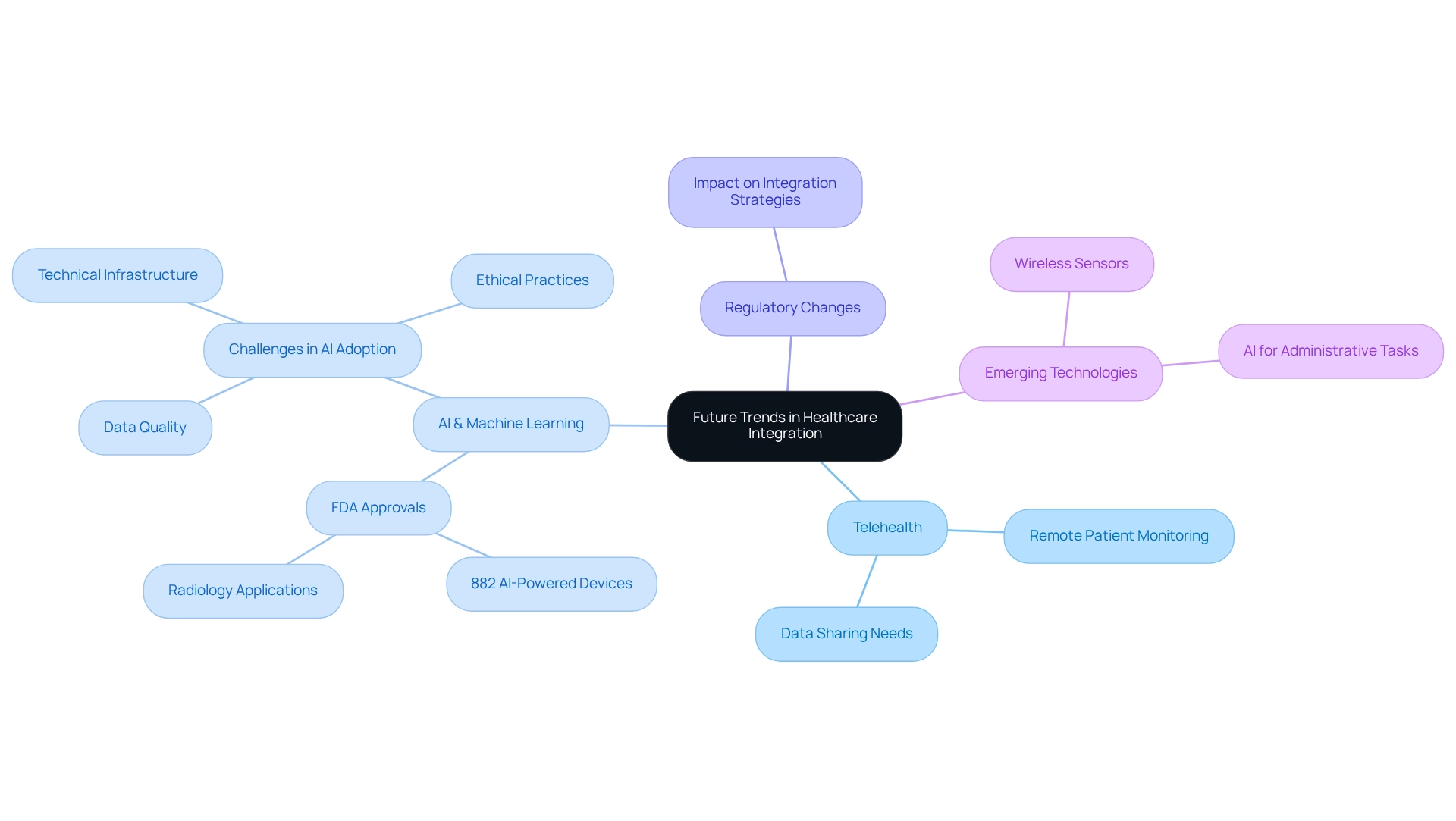
Conclusion
Healthcare system integration is essential for enhancing patient care and operational efficiency. By unifying diverse technologies and enabling seamless communication, organizations can significantly improve outcomes and reduce costs. This article underscores Avato’s pivotal role in simplifying the integration of disparate systems, thereby enhancing data management and overall care quality.
Different integration models—vertical, horizontal, and virtual—offer tailored solutions to address the unique needs of healthcare organizations. The emergence of advanced technologies, such as AI and machine learning, highlights the critical need for real-time data sharing and interoperability.
To address challenges like data silos and staff resistance, engaging stakeholders and providing comprehensive training are crucial. By fostering collaboration, healthcare entities can effectively implement integration strategies that deliver substantial benefits.
As the healthcare landscape continues to evolve, prioritizing integrated systems will be vital in shaping effective future strategies. Embracing these advancements not only enhances operational capabilities but also fosters a cohesive environment that benefits both patients and providers. The imperative for integration is evident; healthcare organizations must act decisively to invest in strategies that ensure improved patient care and outcomes in an increasingly complex environment.

